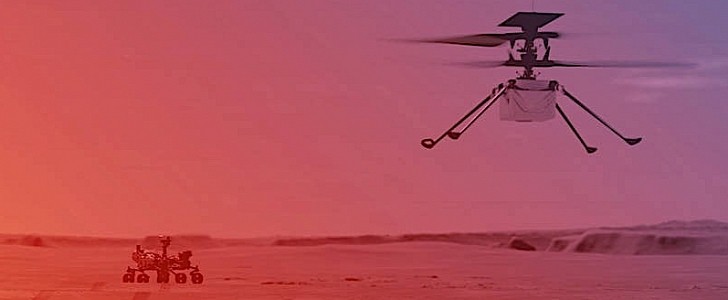It is set: NASA officially announced when it plans to take the Ingenuity helicopter into the air over the reddish Martian plains: “no earlier than April 8.” That's when we’ll be able to witness the first such machine operating in the atmosphere of an alien world.
At the time of writing, the helicopter still remains attached to the underbelly of the Perseverance rover, as NASA showed us not long ago. The six-wheeled machine is presently slowly crawling to the site chosen for the takeoff. Once at its destination, the 30-day window for Ingenuity to conduct its test flights will commence.
NASA feels particularly anxious about the mission, given both the fact this was never attempted before and the challenges posed by Mars. The Red Planet has about one-third the gravity of Earth and an atmosphere that is just one percent as dense as that on our home planet. Both these traits will significantly impact the agency’s attempt at a controlled flight.
To circumvent these challenges, NASA decided to make the helicopter particularly small. The thing weighs just four pounds (1.8 kg), as it's made of lightweight materials like carbon fiber, flight-grade aluminum, silicon, copper, foil, and foam.
Ingenuity will have to be deposited smack in the middle of the 33-by-33-foot (10-by-10-meter) area of Mars chosen for the mission, in order to avoid potential hazards. This type of deployment is also a first, and it makes scientists nervous: it will take Perseverance six Martian days (a bit more in Earth days) to deploy the Ingenuity through a series of well-planned and carefully coordinated maneuvers.
First, the bolt-breaking device will be engaged, releasing the locking mechanism that holds the helicopter glued to the rover. A cable-cutting pyrotechnic device will then detonate, allowing the arm that holds the machinery to rotate it out of its horizontal position.
Ingenuity will extend two of its four landing legs, and this step will be followed by the unlatching of the machine and it becoming vertical. The final two legs will then snap into position, 5 inches (13 centimeters) over the Martian surface. The helicopter will then get its last dose of charging from the rover and drop to the ground.
Once all these steps have been concluded, the actual mission can start. Perseverance will be used as a relay for the instructions sent to the helicopter from Earth, and, at least in theory, things should work out just fine.
Spinning its rotors at 2,537 rpm, Ingenuity should climb at a rate of about 3 feet per second (1 meter per second) until it reaches a height of 10 feet (3 meters). A successful mission would mean it can stay there for up to 30 seconds before gently coming back down.
If all goes well, the flight should open new opportunities to explore the alien world, as humanity will no longer depend on distant, orbiting satellites or slow-crawling machines on the surface.
NASA feels particularly anxious about the mission, given both the fact this was never attempted before and the challenges posed by Mars. The Red Planet has about one-third the gravity of Earth and an atmosphere that is just one percent as dense as that on our home planet. Both these traits will significantly impact the agency’s attempt at a controlled flight.
To circumvent these challenges, NASA decided to make the helicopter particularly small. The thing weighs just four pounds (1.8 kg), as it's made of lightweight materials like carbon fiber, flight-grade aluminum, silicon, copper, foil, and foam.
Ingenuity will have to be deposited smack in the middle of the 33-by-33-foot (10-by-10-meter) area of Mars chosen for the mission, in order to avoid potential hazards. This type of deployment is also a first, and it makes scientists nervous: it will take Perseverance six Martian days (a bit more in Earth days) to deploy the Ingenuity through a series of well-planned and carefully coordinated maneuvers.
First, the bolt-breaking device will be engaged, releasing the locking mechanism that holds the helicopter glued to the rover. A cable-cutting pyrotechnic device will then detonate, allowing the arm that holds the machinery to rotate it out of its horizontal position.
Ingenuity will extend two of its four landing legs, and this step will be followed by the unlatching of the machine and it becoming vertical. The final two legs will then snap into position, 5 inches (13 centimeters) over the Martian surface. The helicopter will then get its last dose of charging from the rover and drop to the ground.
Once all these steps have been concluded, the actual mission can start. Perseverance will be used as a relay for the instructions sent to the helicopter from Earth, and, at least in theory, things should work out just fine.
Spinning its rotors at 2,537 rpm, Ingenuity should climb at a rate of about 3 feet per second (1 meter per second) until it reaches a height of 10 feet (3 meters). A successful mission would mean it can stay there for up to 30 seconds before gently coming back down.
If all goes well, the flight should open new opportunities to explore the alien world, as humanity will no longer depend on distant, orbiting satellites or slow-crawling machines on the surface.

